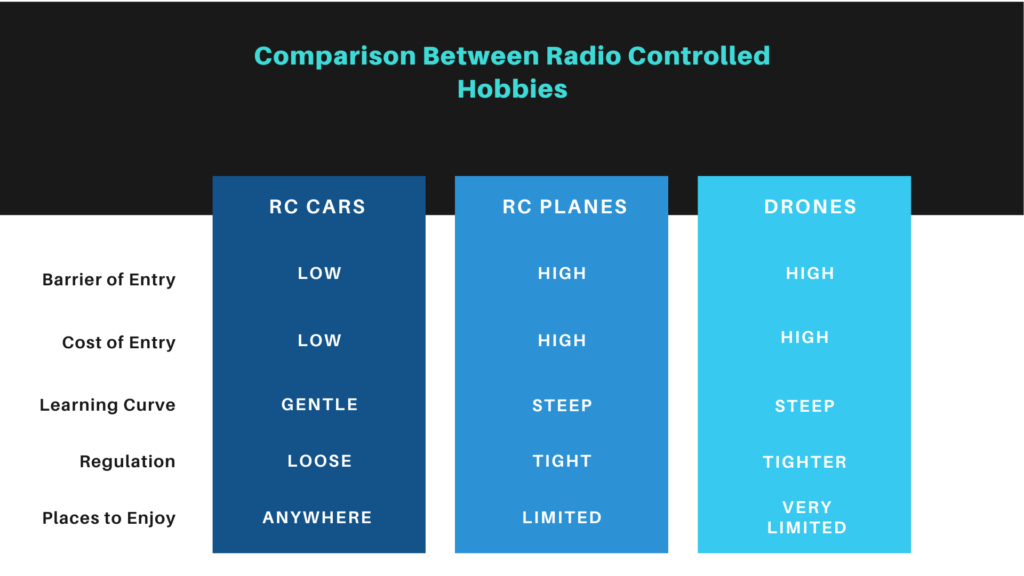Today’s radio-control hobby is generally split into three main categories – RC cars, RC planes and drones. Let’s compare the three and discover the differences that make them thick.
Barrier of Entry
RC cars tend to have a lower barrier of entry compared to RC planes or drones simply because they are easily available and easy to start. You can always find an RC car from a regular toy store and they come with their usual plug-and-play package, or a more exact lingo would be RTR (Ready to Run). RC planes, on the other hand, are less common and most come as separate units while drones have their own niche market.
Cost of Entry
You can purchase a decent RC car for as low as $10. The all-time favorite must be the 2.4Ghz 1:24 scale AE-86 RC drift car. This ultra-low-cost makes RC cars more accessible to anyone from all walks of life compared to RC planes or drones which can cost a lot more. The starting price for a decent drone starts from $30 without a camera and the same goes for RC planes.
Learning Curve
This is pretty much a given for RC ground vehicles. There’s virtually nothing to learn when you unbox a radio-control car, put on the battery and drive away. Even a 5-year-old could do it instantly. However, learning how to fly a drone takes more effort and practice. You need to learn how to control the throttle and how to yaw, pitch and roll, all by using your two thumbs. It takes time to get the hang of it and practice is a must. Otherwise, your quadcopter may crash and burn.
RC planes are the hardest to learn for all radio-control vehicles. Unlike drones where you can hover while being stationary, RC aircraft must constantly move in the air. That is why anyone who wishes to take up RC flying should take up flying in a simulator before heading out to the fields. Of all the skills to master when flying an RC plane, landing would be the hardest for most. For RC cars, “landing” is as easy as hitting the brakes.
Regulation
Let’s start with the one with the most restricted – drones. Drones have gained a rather notorious reputation for being in the wrong place, at the wrong time. This has swayed public opinion to the negative side. There have been heavy regulations enacted to control the use of drones. Most governments require some sort of registration, pilot license, or sitting for an exam. In the U.S., you need to register your drone if it’s above 250 grams (0.56 pounds) and there’s a fee involved. Also, you need to sit for an exam to ensure you’re sufficiently skilled to operate a quadcopter.

RC planes fall almost in the same category as drones and laws regulating radio-control aircraft usually cover both RC planes and drones. However, public opinion on RC planes tends to be more positive since you don’t often see “No RC planes” signs around.
RC cars still managed to hang on to their reputation as the most people-friendly radio-control vehicle. Since its invention in 1955 which ushered in the radio-control hobby, people have been enjoying this hobby without much restriction.
Places to Enjoy
Thanks to drones rather bad rep, some areas have signs that ban drone flying. This limits your opportunity to indulge in drone flying as a hobby. Nonetheless, the good news is that you can still fly your drone inside your home. However, this is impossible with RC planes. So, getting out in the fields or in a wide area comes as a standard practice for RC aircraft pilots. But not everyone lives near a place spacious enough for RC planes. Furthermore, you need to check the wind condition before you take off just to ensure Mother Nature doesn’t sweep your mini airplane off its feet.
Enter RC cars. They are super-easy to be enjoyed virtually anywhere. All you need is a ground surface. The only difficulty is choosing the right surface condition – an RC touring car will not drive well on grass or dirt while a radio-control buggy will tend to skid a lot when it loses traction on a smooth surface like a parking lot.
Table of Comparison
Below is a quick recap of the differences between the three radio-control hobbies in an easily comprehensible table.

This article contains affiliate marketing links and they help pay for our bills.

